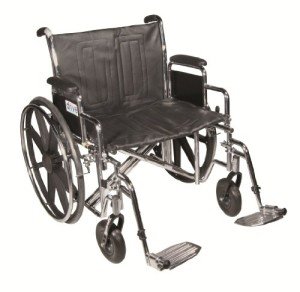Bariatric Wheelchair Seat Width
Seat Width
Having the proper seat width is essential to wheelchair users who invest longer durations in their chairs. Too narrow a seat will cause pressure on the hips and thighs which might lead to sores or pressure points. Having too broad a seat can likewise make it hard for the user to reach the hand rims to propel themselves or maneuver in small areas.

To determine the proper seat width an individual would sit on a chair typically and have their measurement taken across their lap at the best point which is usually their hips. A wheelchair measuring tape can be used to determine this, however a yard stick is chosen as it prevents individuals from covering the tape around their hips which would offer an inaccurate outcome.
The basic wheelchair seat width is 16" (narrow grownup), 18" (standard grownup), and 20" (wide grownup). For bariatric clients, a 24" seat is offered. This sturdy additional large bariatric wheelchair from Medline features swing-away footrests, a carbon steel frame with rust- and chip-resistant chrome plating, and easy-to-clean vinyl upholstery. It has a weight capacity of 500 pounds.
Seat Depth
Typically, the seat depth of a bariatric wheelchair was added 2" to the measurement taken at the user's largest point (usually their hips). This was implied to accommodate additional layers of clothes that might be worn throughout cold weather condition. However, this practice is ending up being less typical as wheelchair users are able to spend more time inside and are not using long coats. This makes the seat depth of a chair lesser when choosing a bariatric wheelchair. However, it is still important to select an option that provides sufficient support for larger users.
The Medline folding additional large bariatric manual wheelchair includes a comfortable 24" seat width and a durable slide tube silver vein frame. It also has an adjustable axle and tool-free elevating legrests.
Seat Height
When it pertains to determining the correct wheelchair seat width you must constantly determine from the user's widest point which is normally their hips. You will likewise require to consider whether the user is going to be using a winter coat as this may include 2" to the width needed.
When a wheelchair remains in use it ought to just be run on level surface areas with the wheel locks fully engaged. This is to avoid the chair from being able to move slopes that are 10 degrees or higher. It is likewise crucial to keep in mind that any activity that may move the center of gravity in the chair need to be finished with care. This includes reaching for products that require the individual to lean out of their seat or trying to stand from it.
Whenever bariatric wheelchair scale have the chair in use it is recommended that you frequently inspect it for damage and oil any areas that are considered necessary. For example, the casters need to be oiled by eliminating the caster fork and utilizing a multi-purpose grease to use to the caster stem bearings. Likewise, bariatric wheelchair 26 inch seat can be changed by loosening up the bolt and then moving them to the preferred position. This allows the feet to sit comfortably on the footplate and avoids any pressure points from forming. This can be extremely uncomfortable for the user and if left ignored, can result in press sores.
Weight Capacity
Bariatric wheelchairs are developed to support more weight than basic wheelchairs. This makes them sturdier and much better equipped to deal with falls. They are likewise typically larger and larger, making them less maneuverable in tight spaces than standard wheelchairs. They need cars with unique ramps and lifts to load them, along with chauffeurs who understand how to best transport them from one area to the next.
When picking a wheelchair, consider its weight capacity as it will be the main determining consider whether it will accommodate your passenger's needs. The weight capacity of the chair is typically noted as a fixed load, suggesting that it indicates the quantity of weight the chair can comfortably hold while stalling. However, bariatric wheelchair 26 inch seat list an active load that is based upon a drop test and can replicate the effect of someone taking a seat in the chair. This might be a more dependable measurement of the weight limit, depending upon your requirements.
If you prepare to carry out activities that move your center of gravity in the seat (such as grabbing items), make sure to have front casters pointed in a forward direction and wheel locks engaged so the chair will not topple. Likewise, inspect that casters are lubed frequently to avoid excessive wear and abrasions. The lubrication treatment involves getting rid of the fork, separating the caster from the wheel, and greasing the caster stem bearings with high-quality multi-purpose grease.
